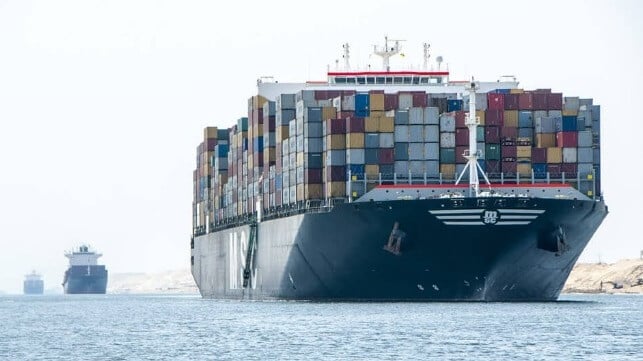The Great Suez Canal Renaissance
Why trade is shifting to the US East Coast Ports via the Suez Canal

The tectonic plates of world trade are shifting. Southeast Asia’s replacement of China as the world’s manufacturing powerhouse has enormous implications for international shipping routes, ports, and supply chains – particularly in the U.S. Complicating this gradual redrawing of shipping trade routes are new environmental policies, increased climate risks, and the need to accommodate an emerging generation of supercarriers. Ports on both U.S. seaboards are already reacting and as with any upheaval, there will be winners and losers.
During the past few decades, U.S. West Coast (USWC) ports enjoyed a greater share of U.S. trade than their Atlantic Coast rivals. This was due to the dominance of China as Asia’s premier manufacturing hub. However, a gradual shift towards US East Coast Ports (USEC) started in 2006, helped by the expansion of the Panama Canal to accommodate vessels of 14,000 twenty-foot container equivalent units (TEU). During this period, traffic to USWC consolidated around the ports of Vancouver and Los Angeles/Long Beach, which together account for around 75 percent of all USWC container traffic.
Last year, the freight handled by USEC ports pipped the USWC by 46 percent to 45 percent. This trend is likely to continue. The route from Southeast Asia – particularly from India which now counts the US as its largest trading partner – is shorter and faster using the Suez Canal-Atlantic route. Furthermore, the Suez Canal can accommodate the large 24,000 TEU supercarriers built to realize economies of scale and lower costs. Also, unlike the Panama Canal, the Suez Canal has so far been unaffected by climate change.
Problems in Panama
By contrast, the Panama Canal is suffering from the worst drought conditions in 73 years. And the long-term prognosis is not exactly rosy either. According to scientists, El Niño, the cyclical warming of ocean water in the equatorial Pacific, is being exacerbated by man-made climate change.
The drop in the canal’s water level caused the Panama Canal Authority (PCA) earlier in the year to impose a 20% draft restriction on vessels and reduce the number of daily crossings. The resulting costly delays and lower volumes show no signs of abating with the PCA saying that it “aims to maintain a maximum draft of 44ft or 13.4m through the remainder of the current year and part of 2024.” Worse still, the number of daily crossings will also be reduced further until February 2024.
In August, the number of daily went from 36 to 32. It will reduce to as few as 18 by February 1, 2024. Consequently, desperate shippers are bidding feverishly for the two daily vacant crossing times the PCA puts to auction. On 8 November, Japan’s Eneos Group made a record queue-jumping bid of $3.97 million, more than $1 million more than the previous top bid of $2.85 million made in October. By comparison, the normal crossing fee is around $900,000.
While climate woes impacting the Panama Canal should further benefit the Suez Canal, concerns over regional tensions escalating and a repeat of the disastrous Ever Green u-turn linger long in the minds of insurers. Neither are champagne corks popping just yet for the USEC ports. The looming overcapacity in the container industry will drive shipping companies to deploy larger vessels on longer routes, such as through the Suez Canal, which can absorb more tonnage. Yet, unlike their larger USWC and European counterparts, no port on the USEC can accommodate the new 24,000 TEU supercarriers.
U.S. ports play catch-up
This growing size/capacity of container carriers is nothing new. Vessels too large to go through the Panama Canal – those at 14,000+ TEU – already represent 14% of the total fleet and a significant 26 percent of future orders.
Not surprisingly, USEC ports are scrambling to dredge and invest in infrastructure to compete for a lucrative part of the Southeast Asia-Suez-Atlantic pie.
The Port of Savannah, Georgia is deepening its channel to up to 52ft (15.85m) so that it can handle 22,000 TEU vessels. The Port of Charleston did the same last year, and the Port of Norfolk Virginia will dredge to 55ft feet (16.76m) by 2024 to provide two-way traffic for the largest supercarriers
Finally, another feather in the cap of USEC ports is that they have enjoyed longer periods without serious labor disputes than their West Coast rivals, although this may be put to the test when new contracts are up for negotiation.
This rebalancing of international trade routes to the US is nothing new and will no doubt happen again. Presently, the pendulum swings in favor of the USEC ports and the Suez Canal.
For now, the unpredictability of the Gulf region and the threat of climate change are the most pressing concerns. The latter must not be lost on policymakers gathering later this month at COP28 in Dubai, for a world without a functional Panama Canal is almost unthinkable.
Jolke Helbing is a director at the international engineering consultancy at Royal HaskoningDHV. He is an expert in the port and shipping industry with a strong record in consulting on the development of high-performance port operations. Jolke has an MSc in Civil Engineering from the Delft University of Technology.
The opinions expressed herein are the author's and not necessarily those of The Maritime Executive.
